FLY RODS
BACK TO TABLE OF CONTENTS
Fly fishing rods are designed to fulfil specific requirements depending on the type of fishing you are doing, so it's really important to make sure you buy the right equipment from the outset. It's a waste of time, effort and money equipping yourself with a small stream rod if you intend going after the monsters that may lurk in the depths of a big lake or reservoir. That may seem like an obvious statement - but it's not quite as easy to get the right equipment as you might expect. It's all about length, strength and flexibility and knowing how these qualities meld together to give you just the right tool for the job. This chapter will give you an insight into these secrets.
A fly fishing rod needs to do several jobs. Firstly it must cast the line, which requires strength and spring so that it can act like a catapult to shoot the line great distance when needed - or very accurately and gently when that's the order of the day. Secondly it must retrieve the line, which requires sensitivity so you can feel the line as it is recovered and know when a fish takes the fly. Thirdly it must fight the fish, which requires the ability to cushion the leader and soak up the shocks as the fish runs and jumps. Finally it must be transportable, which means that it must be capable of being manufactured in sections which come together to act as a whole when assembled.
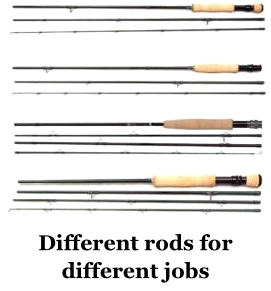 To satisfy these requirements in one rod is very difficult, so rods are made which place more emphasis on one particular quality, often at the expense of the others. A rod with great casting qualities will tend to be stiffer and will be less forgiving when fighting a fish, so it needs to be used with a heavier leader - which may be more easily detected by the fish. A very flexible rod can be used to cast slowly and accurately, will soak up the energetic activity of a small fighting fish but will not cast the line very far and will be unable to handle a large fish. A travelling rod that can be broken down into five or more pieces to fit in your suitcase will have to sacrifice qualities of flexibility or sensitivity. Compromise is often the key.
To satisfy these requirements in one rod is very difficult, so rods are made which place more emphasis on one particular quality, often at the expense of the others. A rod with great casting qualities will tend to be stiffer and will be less forgiving when fighting a fish, so it needs to be used with a heavier leader - which may be more easily detected by the fish. A very flexible rod can be used to cast slowly and accurately, will soak up the energetic activity of a small fighting fish but will not cast the line very far and will be unable to handle a large fish. A travelling rod that can be broken down into five or more pieces to fit in your suitcase will have to sacrifice qualities of flexibility or sensitivity. Compromise is often the key.
The first rule of thumb is - the smaller the fish you are hunting the smaller the rod you should use. A little stream or beck will need a small rod of only four or five feet, whereas big salmon from huge rivers can command rods up to sixteen or seventeen feet in length. Those are the obvious extremes; it's the fishing activities in between where it can get confusing. One rod may be ideal in one circumstance, but unsuitable in another where a rod of the same length might be perfect. So there must be a lot more to it than just length.
Following this rule of thumb, the average trout fisherman approaching a stocked reservoir or lake should be looking for a rod around nine foot six inches or ten feet in length. Loch style fishing on such a reservoir is usually undertaken with a longer rod of eleven foot six inches. Don't worry - I'll explain loch style fishing and why a different length rod is appropriate when we get there (it's in the chapter on going afloat). So the same venue can demand different rods with different qualities depending on how you want to catch your fish. The length is only part of the story. We need to find a way of identifying the power of the rod as well, which will give us a further insight into its best use.
THE AFTM RATING SYSTEM
Equally important as the length of the rod is its power. Power is a relative assessment, comparing one rod against another. So we need a way to make this comparison of one rod with another. We can then decide the fly line that can be used with that rod and the reel needed to accommodate that line. It's like making sure all the pieces of the jigsaw fit. The standard way of describing this quality of power in a rod is by giving it an AFTM rating. That stands for American Fishing Tackle Manufacturers Association. This has long been accepted as the best way to ensure that you are matching rods, reels and lines for maximum effectiveness. It's a bit like making sure that you have the right tyres for your car and that you are using the right kind of fuel - it may work OK with something else but not at full potential. We need to understand this AFTM system if we are to make sure all the pieces of equipment, including the rod, work together.
Historically, the AFTM system was developed to create a uniform method of describing the basic characteristics of a fly line. The most important element of a fly line is its mass, or more simply its weight. In order for lines to perform well with your rod and reel they should have the same weight as any other line you use with that equipment so that each line interacts with the rest of your fishing gear in the same way. It should not matter whether the line is designed to float, sink or something in between, it should still weigh the same as any other line you want to use with that particular rod. This is really important when trying to match the fly line with the fishing rod.
So, the heart of the matter is the actual weight of the line. This was originally measured in grains - which is the smallest international standard unit of weight and is determined as the average weight of a grain of corn. There are 7000 grains to the pound avoirdupois. The avoirdupois weight system of pounds and ounces is the one we all recognise and which was virtually universal before the advent of the metric system based on the gram. There is another weight system using the pound weight, called the troy system but that is now only used to weigh precious stones and metals, although it was once the common weight system in some countries.
The grain is the only common weight in both the avoirdupois and troy systems and thus there are a different number of grains to the pound, depending on which weight system you are addressing. Confusing, isn't it? There are 7000 grains to the pound avoirdupois which is divided into 16 ounces of 437 grains each. There are 5760 grains to the troy pound which is divided into 12 ounces and then into 20 pennyweights of 24 grains each. Both the avoirdupois and the troy system were in use in different parts of the world at the same time, with different actual weights for the pound and ounce. This is the reason why the grain was chosen to weigh fishing lines - it didn't matter which weight system you normally used - the grain weight was the same.
Just to complete the confusion, and for those of a metric disposition, 1 grain = 0.0648 grams. So it was unimportant where in the world you were and what the local weight system was, old fly lines were described by their grain weight, which measured the weight of the first 30 ft (9.14m) of the line. Each line was individually weighed and could have a grain weight that was unique to it and might be only slightly different from another line. This idea of weighing fly lines in grains overcame the problem faced by the British colonials who might be in India or South Africa or in many other outposts and needed to order their fly line from the home country as no lines were made in the country they were currently residing in. They could ensure that they were ordering what they needed without reference to their current country's weight measurement system.
The American Fishing Tackle Manufacturers Association made the sensible decision to simplify this system by converting it into an easy scale which was a step beyond the grain weight system. The idea is to group a range of grain weights into one category, as shown here.
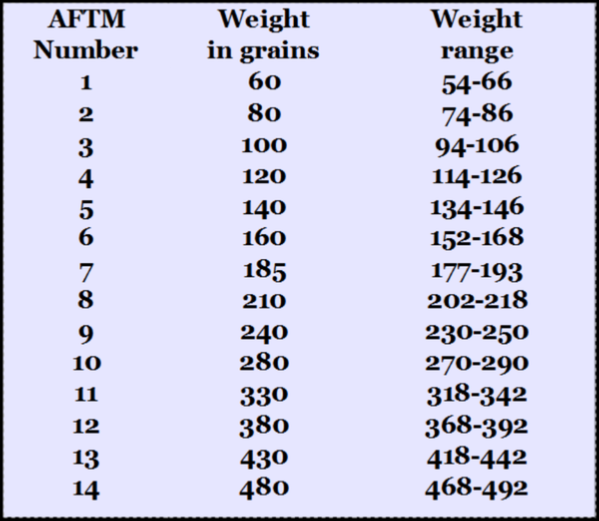
Simply put - the lower the grain weight, the smaller the AFTM number and the lighter and more delicate the line will be - and therefore the rod and reel needed for it. So, those little brook trout which may be no longer than your finger will require an AFTM set up of just 1, whereas the monster salmon and saltwater fish which will test your gear to the limit may need an AFTM kit of 14.
This table can now be simplified even further to look like this:

There will be some overlap and a rod may be sufficiently robust to accommodate slightly heavier use than indicated. Like all things there are the exceptions that prove the rule! You will probably begin to understand that the AFTM rating of a rod gives a good indication of its use. But that is only a part of the story. Imagine a car with a 2 litre engine – easy enough, but that 2 litre engine might be tuned for speed or pulling power and similarly with a rod the AFTM rating gives its loading but not whether that loading is for distance or accuracy.
IT'S ALL IN THE ACTION
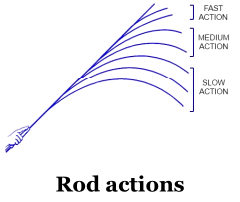 To make things even more complicated, rods are categorised according to their action as well as their length and AFTM rating. This will give an indication of the amount of flex that a rod possesses and the amount of flex is the basis of how fast it can move the line. Essentially, there are three categories of rod action - fast, medium and slow. What this means is the speed that the rod will generate when casting the line and the greater the initial speed the greater the casting distance. The less the rod bends, the faster it will move the line and - vice versa - the more it bends the slower it will move the line, which can be an asset when casting accurately and gently to fish in small streams and becks.
To make things even more complicated, rods are categorised according to their action as well as their length and AFTM rating. This will give an indication of the amount of flex that a rod possesses and the amount of flex is the basis of how fast it can move the line. Essentially, there are three categories of rod action - fast, medium and slow. What this means is the speed that the rod will generate when casting the line and the greater the initial speed the greater the casting distance. The less the rod bends, the faster it will move the line and - vice versa - the more it bends the slower it will move the line, which can be an asset when casting accurately and gently to fish in small streams and becks.
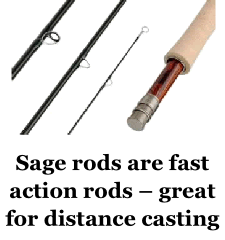 Fast rods have the least flex (bendiness) and this stiffness means that the line comes away from the rod in a tight loop. Alternatively, a slow rod generates a great deal of bend as it casts and this will create a deep loop in the line. You can appreciate that a deep loop will have more of its surface area meeting the oncoming air as it is cast and this will slow it down very quickly. The higher the speed the greater the distance the line will be cast. Without boring you with the mechanics involved it is sufficient to say that the faster the rod the tighter will be the loop that is being generated and a tighter loop will cut through the air for a longer distance. Slower casts are shorter and can be more accurately positioned, ideal for casting to a rising fish on a small stream.
Fast rods have the least flex (bendiness) and this stiffness means that the line comes away from the rod in a tight loop. Alternatively, a slow rod generates a great deal of bend as it casts and this will create a deep loop in the line. You can appreciate that a deep loop will have more of its surface area meeting the oncoming air as it is cast and this will slow it down very quickly. The higher the speed the greater the distance the line will be cast. Without boring you with the mechanics involved it is sufficient to say that the faster the rod the tighter will be the loop that is being generated and a tighter loop will cut through the air for a longer distance. Slower casts are shorter and can be more accurately positioned, ideal for casting to a rising fish on a small stream.
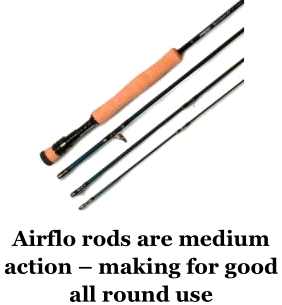 So - the fast action rods are the stiffest and possess great power for long distance casting. To achieve this, the majority of the flex is generated in the top one third of the rod, nearest the tip. This concentration of power and distance is perfect for use on large waters where a lot of area needs to be covered. However, there is always a price to pay and these rods can become tiring to use for an extended period of time. In fact, from my own experience I can tell you that continuous use can result in repetitive strain injury (R.S.I.). But I was using a highly powerful rod for up to seven days a week, so I probably deserved to endure some personal wear and tear!
So - the fast action rods are the stiffest and possess great power for long distance casting. To achieve this, the majority of the flex is generated in the top one third of the rod, nearest the tip. This concentration of power and distance is perfect for use on large waters where a lot of area needs to be covered. However, there is always a price to pay and these rods can become tiring to use for an extended period of time. In fact, from my own experience I can tell you that continuous use can result in repetitive strain injury (R.S.I.). But I was using a highly powerful rod for up to seven days a week, so I probably deserved to endure some personal wear and tear!
Medium action rods are good for general purpose and will develop a slower more comfortable style of casting. Because the action generates power over the top half of the rod it follows that the cast will have a deeper loop to it, giving more control over matters. It will keep the leader and flies away from the lower part of the line as it is being cast, so things aren't as likely to get all tangled up mid cast. This is a much easier and more comfortable fishing style and I would recommend it for the beginner.
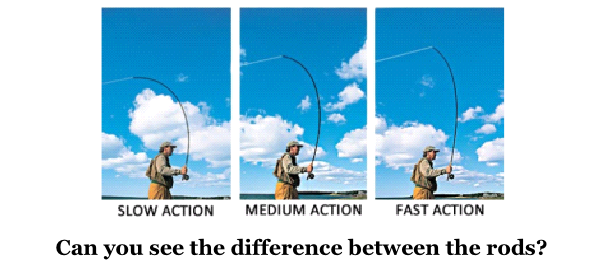
Finally, slow or progressive action rods develop their power over nearly the entire length of the rod. This makes for a very slow and lazy cast which cannot be hurried. This will suit short distance fishing with a floating line, where accuracy is more important than distance. They are ideal for the small trout stream where presentation to a feeding fish is all about accuracy and stealth and you are doing little more than laying the line onto the water.
Here are two videos giving two fishing guides’ suggestions on the suitability of various fly rods.
You may be able to fish with just one rod quite satisfactorily to begin with. However, it is inevitable that, as you become more experienced, you will realise that you need more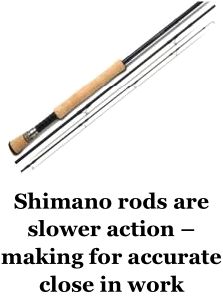 than one rod to meet changing circumstances, such as wind or the depth that the fish are lying. I was fortunate enough to own a matched pair of rods so that I could have two different lines set up. This was useful when fish were varying their depth and different sink rates of line were needed. Again, we'll get to how you work all that out, but for now it is sufficient to say that you'll be buying more than one rod as you get more into the sport.
than one rod to meet changing circumstances, such as wind or the depth that the fish are lying. I was fortunate enough to own a matched pair of rods so that I could have two different lines set up. This was useful when fish were varying their depth and different sink rates of line were needed. Again, we'll get to how you work all that out, but for now it is sufficient to say that you'll be buying more than one rod as you get more into the sport.
If you are setting out, as most do, to gain your experience on one of the reservoirs or lakes stocked with fish around the one kilo mark then my advice would be to look at a rod of around nine foot six inches with an AFTM rating of seven and a medium action. This will give you the widest range of usage from a single rod, as it can accommodate both floating and sinking line set-ups quite comfortably and is relatively easy to cast.
All rods come in several pieces and you should ensure that the rod you are selecting is practical - I once purchased a rod which I later discovered was too long to fit in my car boot. It had to be stuffed between the chairs in the passenger area - until someone forgot and adjusted the car seat and chopped the rod into even more pieces that it should have been!
The point at which two rod sections are connected are called the ferrules. These should always be kept clean and grit free to avoid undue wear. If the ferrules start to wear through use you run the risk of the rod sections coming apart at the critical point of casting or, even worse, when playing a fish. When assembling your rod you should always ensure that the ferrules are bone dry. Any wetness on the surfaces will act as a seal and create a vacuum inside the joint. That's why it can be so difficult to separate the sections when you try to take it apart.
TIP To tighten up loose ferrules rub the male end with candle wax - this will fill the gap caused by wear.
TIP To separate two rod sections that have seized together, grip them behind your knees and use the power of your legs to help pull them apart.
ROD CONSTRUCTION
The first rods were very simply constructed of cane but these were not very user friendly or robust. It was soon discovered that a better rod could be made by splitting the cane into long section and gluing these sections together to form a much stronger and more reliable rod. You can tell these rods from their hexagonal cross-section - six sections of bamboo cane glued together. Here is a video of the construction of a bamboo fly rod.
These next two videos are from Doug Moody, a traditional cane fly rod manufacturer in the Adirondacks in New York State. He uses traditional methods with modern tools - a perfect blend of past and present.
B ecause they are very flexible, they have a very slow action and are ideal for the accurate presentation of dry flies with a floating line on small streams. With the intervention of science newer and ever more exotic materials were tried. Initially, glass fibre was the medium of choice, moving through to such exotic materials as boron - even exotic metals have been tried. We have now arrived at a place where the vast majority of rods are constructed of a carbon laminate material which gives the best power to weight ratio that can be achieved for a reasonable cost. Each section is made by rolling a carbon fibre sheet impregnated with resin round a former – like rolling a sheet of paper round a pencil. The former the carbon sheet is rolled around is called a mandrel. When the resin has cured the mandrel is withdrawn leaving the hollow rod section. This basic format without any bits on it is called a blank.
ecause they are very flexible, they have a very slow action and are ideal for the accurate presentation of dry flies with a floating line on small streams. With the intervention of science newer and ever more exotic materials were tried. Initially, glass fibre was the medium of choice, moving through to such exotic materials as boron - even exotic metals have been tried. We have now arrived at a place where the vast majority of rods are constructed of a carbon laminate material which gives the best power to weight ratio that can be achieved for a reasonable cost. Each section is made by rolling a carbon fibre sheet impregnated with resin round a former – like rolling a sheet of paper round a pencil. The former the carbon sheet is rolled around is called a mandrel. When the resin has cured the mandrel is withdrawn leaving the hollow rod section. This basic format without any bits on it is called a blank.
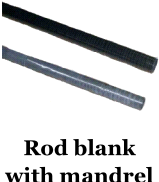 While most rods are purchased at your local fishing tackle dealer or through the Internet, it is also possible to find a rod maker who will build a bespoke rod to your own specifications for a quite reasonable price. But that pre-supposes that you will know what your requirements are! It is probably best to stick your toe in the water by purchasing a pre-made rod to begin with and then move on to more specific rod construction when you know what you really need.
While most rods are purchased at your local fishing tackle dealer or through the Internet, it is also possible to find a rod maker who will build a bespoke rod to your own specifications for a quite reasonable price. But that pre-supposes that you will know what your requirements are! It is probably best to stick your toe in the water by purchasing a pre-made rod to begin with and then move on to more specific rod construction when you know what you really need.
These great videos are about rod construction and answer a lot of questions.
TIP You can always identify a fly rod from any other type - the reel seat of a fly rod is set at or very close to the end of the butt (handle) - apart from the double handed salmon rods that are so big they cannot be mistaken for anything else!.
Most rods are made in two, three or even more sections, depending on whether you prefer portability or innate strength. The more sections there are, the stiffer the rod will tend to be as the joints will have no give in them which will affect the overall shape the rod will take when under load.
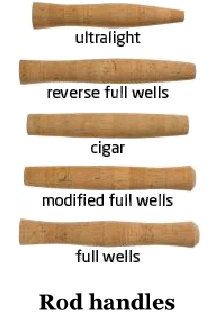 Rods are furnished with a cork handle - other materials have been tried but cork remains the favourite. The handle comes in a variety of shapes, each of which lends itself to a particular method of fishing. The full wells is normally seen on a rod used in distance casting, where the shape gives a good leverage point for the thumb. The reverse full wells and ultra-light handles are used in precision close casting where accuracy is more important than distance.
Rods are furnished with a cork handle - other materials have been tried but cork remains the favourite. The handle comes in a variety of shapes, each of which lends itself to a particular method of fishing. The full wells is normally seen on a rod used in distance casting, where the shape gives a good leverage point for the thumb. The reverse full wells and ultra-light handles are used in precision close casting where accuracy is more important than distance.
Line guides are essentially wire rings and are what the line passes through as it travels up the rod. These can be attached to the rod with either one or two legs. Some rods have line guides that have high slip inserts to help with the passage of the line. This insert is made from ceramic or aluminium oxide. Both these materials offer little friction and are very hard wearing.
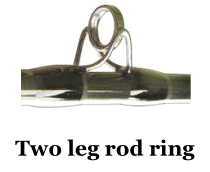 On other rods these guides are made of a hard chromed wire bent into an S shape, known also as a snake ring. It's a question of personal preference, if you have the choice. I have always used single leg guides with an aluminium oxide insert as they keep the line away from the rod and avoid wear. S shaped guides allow the line to come in contact with the body of the rod, which may cause wear on the fly line - you can actually hear the line slapping against the rod as it moves at speed. A stripping guide is the name of the last guide before the rod butt and is much bigger than the other guides. Its name derives from the action of stripping back the line at high speed, for example when retrieving a fry imitation.
On other rods these guides are made of a hard chromed wire bent into an S shape, known also as a snake ring. It's a question of personal preference, if you have the choice. I have always used single leg guides with an aluminium oxide insert as they keep the line away from the rod and avoid wear. S shaped guides allow the line to come in contact with the body of the rod, which may cause wear on the fly line - you can actually hear the line slapping against the rod as it moves at speed. A stripping guide is the name of the last guide before the rod butt and is much bigger than the other guides. Its name derives from the action of stripping back the line at high speed, for example when retrieving a fry imitation.
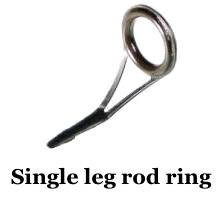 These days most rods will give details of its length and AFTM rating often referred to as its weight (meaning the line weight it uses and not to be confused with how much the rod actually weighs!). This information is printed on the rod, usually just above the handle in a code. For example, 10.0 - 7 will indicate a ten foot rod with an AFTM rating of 7. However this will not tell you whether it is a fast, medium or slow action rod. You'll have to dig that bit of information out of the technical specifications from the manufacturer - and quite often they do not supply this!
These days most rods will give details of its length and AFTM rating often referred to as its weight (meaning the line weight it uses and not to be confused with how much the rod actually weighs!). This information is printed on the rod, usually just above the handle in a code. For example, 10.0 - 7 will indicate a ten foot rod with an AFTM rating of 7. However this will not tell you whether it is a fast, medium or slow action rod. You'll have to dig that bit of information out of the technical specifications from the manufacturer - and quite often they do not supply this!
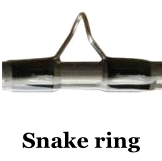 Unfortunately, the only way of finding out whether you are going to get on with a rod is to use it for a while - which is a bit like putting the cart before the horse. You are unlikely to find a dealer who will agree to letting you take it fishing before you buy it! You really do get what you pay for, so an expensive rod from a reputable manufacturer is a good investment for the future; you should aspire to that and start off with a reasonably priced rod until you know more about what you are doing.
Unfortunately, the only way of finding out whether you are going to get on with a rod is to use it for a while - which is a bit like putting the cart before the horse. You are unlikely to find a dealer who will agree to letting you take it fishing before you buy it! You really do get what you pay for, so an expensive rod from a reputable manufacturer is a good investment for the future; you should aspire to that and start off with a reasonably priced rod until you know more about what you are doing.
While trout rods are designed to be used single handed, the larger salmon rods are equipped with an additional section of handle below the reel seat. This enables them to be used double handed, a necessity on large rivers where roll casting and Spey casting are used and back casting may not be possible. Don't worry about these new terms like roll casting - all will be revealed as you move through the various sections. Finally, a rod should be supplied with its own cloth bag. Some of the more expensive rods will even come with a plastic or metal case to offer maximum protection during transportation. You should get into the habit of keeping your rods in its case in a clean condition. Dirt and grit will erode the protective finish on the rod and dramatically shorten its life.
SINGLES AND DOUBLES
As mentioned above, fly rods come in single or double handed forms. Light weight rods are capable of being used with a single hand but the heavier salmon and sea rods require the use of both hands to get them working. You can see how this works in the Casting section, where casts such as the Spey cast require the use of both hands. Just to confuse the issue, manufacturers have recently introduced an intermediate form of rod called a switch rod which falls in between the two types. This rod has a larger fighting butt than a normal single handed rod, which can also be used as the grip for the other hand in double handed casting.
